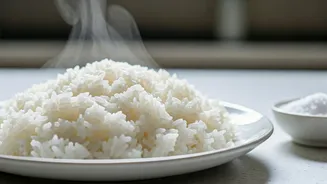Excessive Stickiness
When rice ends up overly sticky, it can be a real disappointment. This often happens because of a couple of common reasons. Firstly, there might have been
too much water used during the cooking phase, causing the rice grains to absorb excessive liquid and bind together. Secondly, the type of rice itself can contribute to the problem; some varieties are naturally stickier than others. However, there are ways to fix this. Add a small amount of cold water to the sticky rice and then reheat it gently, such as in a steamer or microwave. This can help loosen the grains. To prevent this issue in the future, it's essential to follow the correct water-to-rice ratio as indicated on the rice packaging. Additionally, rinsing the rice before cooking removes some of the excess starch, which in turn reduces the likelihood of stickiness. Finally, letting the cooked rice rest, uncovered, allows excess moisture to evaporate, further preventing the grains from clumping together. Consider using a rice cooker, as it is designed to cook rice perfectly, avoiding stickiness.
Garlic Gone Wild
Sometimes, the enthusiasm for garlic can lead to an overpowering flavor in your dishes. This can be easily fixed by a couple of techniques. The most obvious of these would be the addition of acidic elements such as lemon juice or vinegar, which can effectively balance the strong garlicky taste. Dairy products, like milk or cream, can also do the same. Sweeteners, such as sugar or honey, will help cut some of the sharpness. If possible, incorporating a starch, like potatoes or rice, will absorb some of the excessive garlic flavor. Another option is the addition of fresh herbs, such as parsley or basil, which can add a complementary flavor and round out the dish. If the garlic is raw, remember that sautéing it first will reduce its sharpness. In case the garlic has already been cooked, don't worry, there are still ways to adjust the balance.
Too Much Salt?
A salty dish can be quite unpleasant, but it is not the end of the world. The easiest method to resolve this is to dilute the saltiness by introducing water, broth, or ingredients lacking salt. Vegetables or grains would be a perfect addition. Sweet and acidic flavors can also counteract the excessive salt, such as sugar, vinegar, or lemon juice. Dairy products such as cream or yogurt are also viable solutions. Another effective method involves integrating a starchy ingredient to absorb the extra salt. You can also opt to double the recipe, prepare an additional batch without adding salt, and then mix both. This effectively reduces the salt concentration. Make sure that when testing the food, all the ingredients are well distributed.
When Sweet Is Too Much
When a dish turns out overly sweet, it is simple to fix with complementary flavors. Incorporate acidic elements like lemon or lime juice or vinegar to balance the sweetness. Adding a small amount of salt can also diminish the excessive sweetness. If the dish includes a sauce or liquid, add unsweetened ingredients to dilute the sugar content. You can also experiment with herbs and spices to balance the overall taste profile. If you have baked goods, a pinch of salt will work. If the dessert has already been baked, it can be served with a dollop of unsweetened whipped cream or yogurt to counteract the sweetness. It is also important to remember to adjust the amount of sugar according to your preferences.
Handle the Heat
When food becomes excessively spicy, there are several methods you can use to reduce the intensity. One of the best options is dairy products, such as milk, yogurt, or sour cream, which contain casein. Casein helps bind to capsaicin, the compound responsible for the spiciness. Sweet elements like honey or sugar can also help. Acidic ingredients like lime juice or vinegar can also calm down the heat. Starchy foods, such as rice or bread, are also useful. Coconut milk is also a great option. To prevent this from happening, add spices incrementally and remove seeds and membranes from chili peppers.
Pasta Mishaps Solved
Overcooked pasta can be a setback, but it is still salvageable. The first step to take is to drain the pasta and rinse it immediately under cold water. This will help stop the cooking process immediately. Incorporating the pasta with the sauce will allow it to reabsorb some of the flavor and improve its texture. Tossing the pasta with some olive oil can prevent it from sticking together. If the pasta is extremely overcooked, you can use it in a casserole or pasta salad. In the future, remember to keep an eye on the cooking time and taste-test the pasta before the suggested time. It is also recommended to add salt to the cooking water.
Disposing of Used Oil
Dealing with used cooking oil might seem tricky, but there are simple ways to manage it. Let the oil cool completely. Strain the oil through a fine-mesh strainer or cheesecloth to get rid of food particles. For small quantities of oil, pour it into a sealed container and toss it in the trash. You may be able to take it to a local recycling center. Never pour oil down the drain because it can clog your pipes. Don't mix used oil with other liquids. If you have been frying at a lower temperature, and the food has not been overly flavored, you can reuse the oil.







